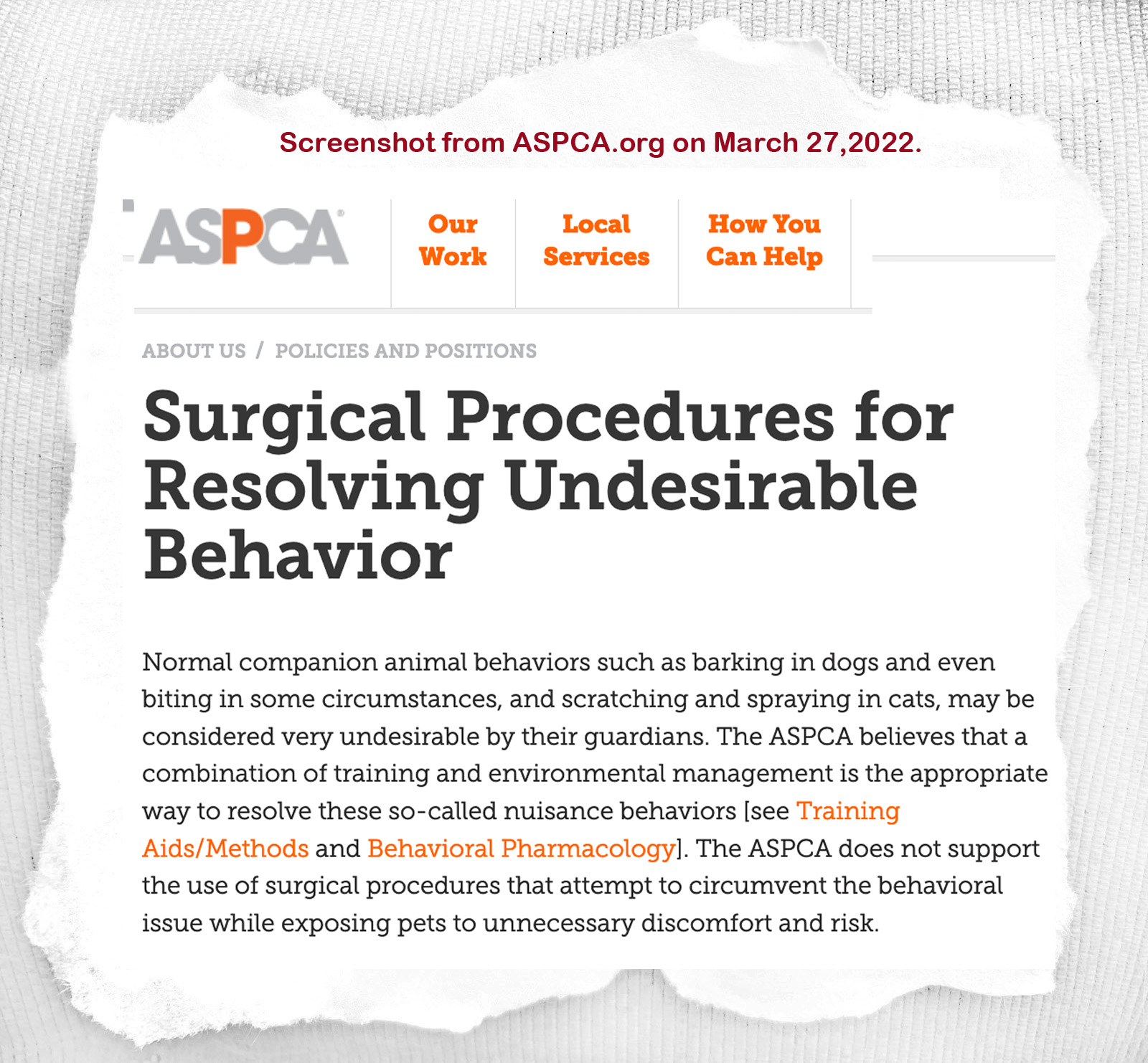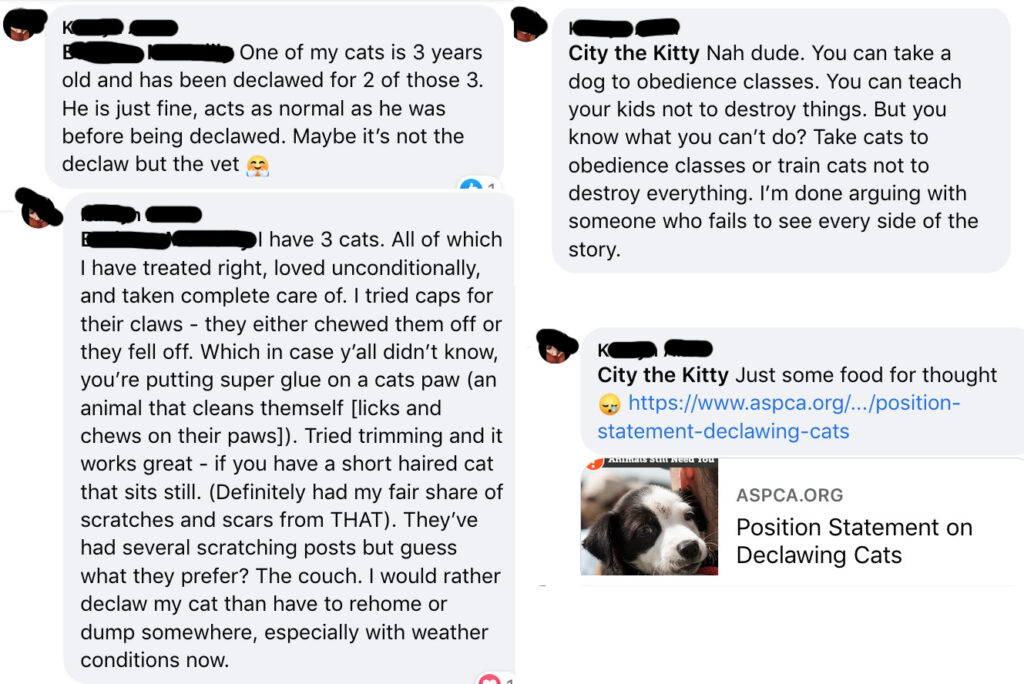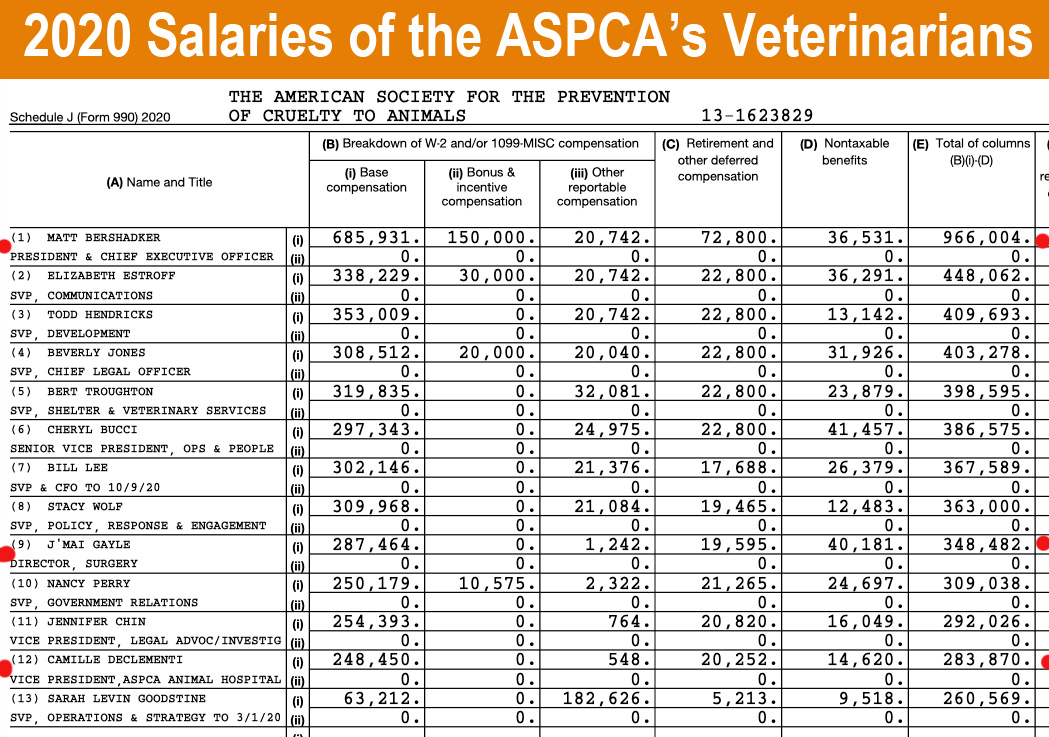January 12, 2022
City the Kitty nonprofit is calling on animal lovers across the world to investigate the ASPCA on why they do not want declawing banned and why they have a declawing position statement that is on the side of declawing veterinarians and not cats. Please take 60 seconds and sign our petition to the ASPCA. ASPCA petition
The ASPCA does a lot of good things to help animals but unfortunately they do not want declawing banned. ASPCA’s declawing statement
If the ASPCA has a declawing position statement that completely condemns this animal cruelty (declawing) and helps pass laws to ban it, then more cats would be protected from this inhumane, cruel, and very harmful amputation procedure. Look at the legislative work that they support. ASPCA’s policy priorities
THE ASPCA’S DECLAWING POSITION IS BEING USED BY PRO=DECLAWING VETS AND THEIR ASSOCIATIONS TO STOP THE BILLS. BECAUSE OF THIS, DECLAWING VETS ARE BEING HELPED BY THE ASPCA TO CONTINUE PERFORMING AND PROFITING FROM THIS BARBARIC CAT CRUELTY. HERE IS THE PROOF! Story- ASPCA IS HELPING DECLAWING VETS PROFIT FROM THIS CRUELTY
Why wouldn’t the ASPCA want a cruel, inhumane and unnecessary amputation procedure banned, especially since it is not only bad for cats but it’s bad for veterinarians, veterinary professionals and cat owners. Here’s our story. Declawing is bad for veterinarians, cat owners, and cats.
The ASPCA keeps changing the excuse to condone declawing.
The ASPCA has two veterinarians in their top positions.
Dr J’Mai Gayle, Director of Surgery
ASPCA Animal Hospital
424 E 92nd St
New York, NY 10128-6804
Here is Dr J’Mai Gayle’s facebook page. Director of Surgery at ASPCA animal hospital
Dr Camille Declementi, Vice President of the ASPCA Animal Hospital. 424 E 92nd St
New York, NY 10128-6804
Here is Dr Camille DeClementi’s facebook page. VP of ASPCA’s facebook page
In 2019 their CEO, Matthew Bershadker, made over $800,000.
In 2020 their CEO, Matthew Bershadker, made over $950,000.
In 2021 their CEO, Matthew Bershadker, made over $980,000.
In 2022 their CEO, Matthew Bershadker made over $1.100,000.
We reached out to these two ASPCA veterinarians and the ASPCA to ask them if they wrote up the ASPCA’s declawing position statement but never received an answer. Donate@aspca.org or publicinformation@aspca.org or grassroots@aspca.org
If you know how to contact them, please send us an email. citythekitty@gmail.com
———————————————————————
The ASPCA says that declawing can save a cat from being euthanized. Where is their data that proves this? There is none.
Declawing does not save the lives of cats and in fact the opposite often happens and thousands of declawed cats each year are abandoned or relinquished to shelters because of the behavioral issues they develop from their toe bone amputations. Many of these declawed cats are euthanized.
Declawing is banned in New York state and many cities in America and the laws are enforceable by officials in those locations. The ASPCA did NOT support the declaw bill in their own state.
Why did the ASPCA change their excuse to condone this animal cruelty (declawing)?
Excerpt from a Story in the Washington Post in 1998.
“The claw of a cat is the anatomic counterpart of the last phalanx, or bone, of a human finger or toe. A cat uses its claws to defend itself, to seize prey, to climb, to help balance as it walks and to mark territory. The principal reason for routine scratching is to peel the old sheaths off the nails, said Jacque Schultz of the ASPCA. “The new nail grows inside the old nail,” she said. Scratching also seems to be a form of exercise, an instinctual feline yoga that stretches and presumably refreshes.
The ASPCA recognizes exceptional cases, Schultz said. “If you live in a household where someone has a physical complication {for example, geriatric diabetes or AIDS} where a scratch could mean the loss of a limb or a severe infection . . . we’re not telling people put your own health at risk just so the cat can keep its claws. If you have tried everything, if you’re at the point of turning the animal into the local animal shelter, then get the animal declawed.”
The ASPCA’s declawing position statement in 2015 and before: “ The ONLY circumstance in which the procedure could be condoned would be if the health and safety of the guardian would be put at risk, as in the case of individuals with compromised immune systems or illnesses that cause them to be unusually susceptible to serious infections.”
The ASPCA’s declawing position statement in 2016. ” The ASPCA is strongly opposed to declawing cats for the convenience of their owners or to prevent damage to household property. The only circumstances in which the procedure should be considered are those in which all behavioral and environmental alternatives have been fully explored, have proven to be ineffective, and the cat is at grave risk of euthanasia…”
The ASPCA’s full statement- https://www.aspca.org/about-us/aspca-policy-and-position-statements/position-statement-declawing-cats
Here’s the ASPCA’s Destructive Scratching page where they ask, “Should you declaw your cat?” https://www.aspca.org/pet-care/cat-care/common-cat-behavior-issues/destructive-scratching
Both of those excuses are outdated and not supported by current peer-reviewed, scientific evidence and data.
Also the ASPCA says that surgery should not be used to correct a behavioral issue. Link- ASPCA Surgical Procedures for Resolving Undesirable Behavior
The ASPCA’s declawing position statement is being used to defeat legislation that would protect innocent cats from this barbaric animal cruelty.
April 2023. Illinois. The President of the Illinois State Veterinary Medical Association, Dr Joanne Carlson, is using the ASPCA’s declawing position in her numerous Letters to the Editor in Illinois newspapers to try to STOP the Illinois anti-declawing bill.
Here’s an excerpt from this Letter to the Editor by Dr Carlson. “Cat declawing is not common in Illinois, and ISVMA stands firmly with the American Society for the Prevention of Cruelty to Animals, one of the world’s largest humane societies, in asserting that declaw procedures be a last resort.”
Here’s more about this story about how the ISVMA and Dr Joanne Carlson are putting out blatant lies and misinformation about declawing. They also saw our survey that showed that declawing is common in the majority of vet clinics in Illinois but they are ignoring it and putting out the lie that declawing is not common. https://citythekitty.org/lying-to-legislators-illinois-state-veterinary-medical-assoc-has-to-lie-about-declawing-because-the-truth-about-it-is-just-so-brutal-and-awful/
March 2022. Arizona. Here’s an example of how the lobbyist with the AzVMA used the ASPCA’s declawing position statement on March 23, 2022, during her testimony to oppose the anti-declawing bill in AZ. AzVMA lobbyist uses ASPCA’s declawing position
2021. Wyoming. Here’s a 2 minute video showing you an example of an AAHA.org declawing vet who helped stop an anti-declawing ordinance in WY in 2021. Declawing vet using the ASPCA’s declawing statement to stop an anti-declawing ordinance
Pro-declaw cat owners are using the ASPCA’s declawing position statement to justify having it done to their cats.
Declawing veterinarians are using the ASPCA’s declawing position statement to justify keeping this cruel, mutilating, and unnecessary amputation procedure legal so they can keep making easy and good money from it.
Why doesn’t the ASPCA follow the latest science, data, and peer reviewed studies about declawing and completely condemn it and help pass laws to end it?
Also, the ASPCA refers people to the American Animal Hospital Association (AAHA) for veterinary care. Here’s the link. The ASPCA refers to AAHA hospitals
AAHA says in their official declawing posiition statement that they strongly oppose declawing and explain that veterinarians should tell their clients that declawing is no longer a reasonable or supported procedure. But then AAHA says if veterinarians are going to declaw, they should use pain meds before, during, and after. So why is AAHA against this barbaric and inhumane cat mutilation but then they ultimately condone it?
More about AAHA and how they allow declawing in their accredited hospitals, how they sicced their lawyers on us, and how their veterinarians try to stop the anti-declawing bills with the ASPCA’s position statement. AAHA puts profits over the welfare of cats
The ASPCA and AAHA need to follow in the footsteps of all the ethical and humane organizations who are 100% against declawing and have banned it in their vet practices like VCA, AAFP, Mission Veterinary Partners, Petsmart veterinary services, Petco Vetco, Bond Vet, Banfield, Fear Free Pets, Ethos Veterinary Health, etc.
The American Association of Feline Practitioners (AAFP) has stated, “There is no current peer-reviewed data definitely proving that cats with destructive behavior are more likely to be euthanized, abandoned, or relinquished.” AAFP’s declawing position statement. https://catvets.com/guidelines/position-statements/declawing
VCA stated, “It is a common misconception among veterinary professionals that scratching behavior is one of the most common reasons for relinquishment of cats to shelters. Our experience and that of shelter operators has taught us differently. Other problems, house soiling and aggression, are listed as the top two behavioral reasons cats lose their homes. Scratching behavior is far down the list, right next to reasons like the cat requires too much attention, and scratching is rarely a reason given for relinquishment.” https://citythekitty.org/vca-animal-hospitals-stopped-declawing/
VCA and Banfield banned declawing in all their 2000 + vet clinics in early 2020.
Fear Free Pets, AAFP, and Mission Veterinary Partners also banned declawing in 2021.
———————————————————————————————
This peer reviewed study in 2021 showed that banning declawing does not result in more cats relinquished to shelters or euthanized. https://pubmed.ncbi.nlm.nih.gov/34514907/
Here’s a 2018 quote from Heather Cammisa the Pres. & CEO of the biggest shelter in NJ, St Hubert’s Animal Welfare Center. “My communications to legislators and others included statements that destructive behavior is not a significant reason for surrender, nor is it a top call to our pet helpline and therefore that a ban, in our expert opinion, would not increase relinquishment (and the corresponding alarm of euthanasia), as is claimed by some in the veterinary community.”
Declawing was banned by veterinarians in Nova Scotia in 2018. We asked the SPCA Nova Scotia’s Director of Programs & Administration in March of 2019 if they had more cats coming into their shelter after the ban on declawing. She said, “We’ve seen very little impact, some critics thought we would see an increase in owner surrenders for destructive scratching however that has not been the case.”
Here’s a statement Brenda Barnette, General Manager of Los Angeles Animal Services Dept., “I am the General Manager of Los Angeles Animal Services Department (LAAS), which operates the public animal shelters in Los Angeles, a city of over 4 million. Los Angeles, where declawing has not been permitted since 2009, has a proud tradition of being on the forefront in the humane treatment of animals.
Since the declaw ban, the number of cats entering our shelters dropped 43.3%. I attribute the decrease in relinquishment of cats to a decrease in behavioral problems, particularly biting and litter box avoidance, which are widely recognized to be the result of declawing and that are reasons for cats to be surrendered to shelters. Furthermore, our adoption rate for cats has actually increased. We at LAAS strongly believe that a no-declawing policy saves the lives of cats.”
Declawing was banned in New York State in July 2019 and there hasn’t been an increase of cats in shelters or cats being euthanized in that state.
Here is a June 26, 2020 statement from the biggest animal shelter in the world that is based in New York. North Shore Animal League America.
“We are approaching the one year mark since the ban went into effect on July 22nd, 2019. We have not seen an increase in owner surrendered cats as a result of the ban. NSALA supported the ban and did not provide declawing services in our Pet Health Centers even before the ban went into effect. There are many other humane options to address the cat’s innate need to scratch. We have seen firsthand the damage caused by declawing both physically and behaviorally when owners want to surrender their declawed cats. We are happy to know that this practice has stopped in New York.
Joanne Yohannan, Senior Vice President of Operations, North Shore Animal League America”
Here’s another statement from Animal Care Centers of NYC .
“June 26, 2020
Anyone thinking that the declawing ban would lead to an increase in cat surrenders in New York City might be surprised to learn that ACC, the only open-admission shelter in NYC, has actually seen a decline in cat intake. At the same time we have seen a 25% increase in the amount of direct adoptions our organization has processed over the past year. The ban does not seem to have affected people’s desire to adopt cats in their natural state.
Katy Hansen
Director of Marketing and Communications
Animal Care Centers of NYC”
WHAT YOU CAN DO.
3) Send a polite note to Subaru and ask them to inspire the ASPCA to support banning declawing and to completely condemn it. Subaru is the largest corporate donor to the ASPCA. They’ve donated 30 million dollars to the ASPCA since 2008. Email- customer@subaru.com
“Dear Friends of Animals,
Thank you for contacting the ASPCA.
Declawing is one of the most controversial issues in the pet care realm. The ASPCA is opposed to routine declawing of cats. It should be reserved for cases where there are health issues involved or all efforts to retrain the cat to scratch in appropriate areas have been exhausted.
Laser surgery for declawing is considered to be superior to the traditional surgery methods. There is less bleeding and pain, and the recovery time is much shorter.
Declawing is a painful procedure, and is an actual amputation of the first segment of a cat’s toes. A cat will lose his first line of defense and may have some trouble climbing because he can’t sink his claws into the surface and shift his weight to help balance himself.
There have been no scientific studies that prove that there are any behavioral repercussions from declawing a cat — only anecdotal claims that declawed cats are more likely to soil out of the litter box, bite or hide.
Declawing is illegal in much of Western Europe but a fairly common procedure in American veterinary offices.
For further information on the ASPCA or other humane issues, you may wish to visit our website at http://www.aspca.org.
Thank you for your concern and for being an animal welfare advocate.
Sincerely,
Heizl
The ASPCA
Public Information Department”
Here’s the note they sent us in March 15, 2017.
“Apologies for the delay in getting back to you. It looks like you’ve already viewed our updated position on cat declawing: http://www.aspca.org/about-us/aspca-policy-and-position-statements/position-statement-declawing-cats. We continue to strongly oppose the procedure. As noted in the statement, our experts believe that legislation to make declawing illegal, while well-intentioned, can be problematic, because, in rare cases, the procedure may be justifiable as a last resort to prevent euthanasia.
All the best,
Olivia
Olivia Melikhov
Senior Manager, Social Media
Media and Communications
ASPCA®”
Here is a note they sent to us in 2015.
“Thank you so much for reaching out and apologies for the delay in getting back, I had to consult with a few departments and experts internally here. Our organization is opposed to the inhumane practice of cat declawing and we think it’s really admirable that you and City the Kitty are working to raise awareness about this important issue. We are actually in the process of working with our experts to revise and update our position on declawing. In the meantime, we are refraining from participating in proactive advocacy on the issue.
All the best,
Olivia
Olivia Melikhov
Senior Manager, Social Media
ASPCA®
520 Eighth Avenue, 7th floor
New York, NY 10018″
2019 990 form.
2020 990 form.
2022 990 form.







